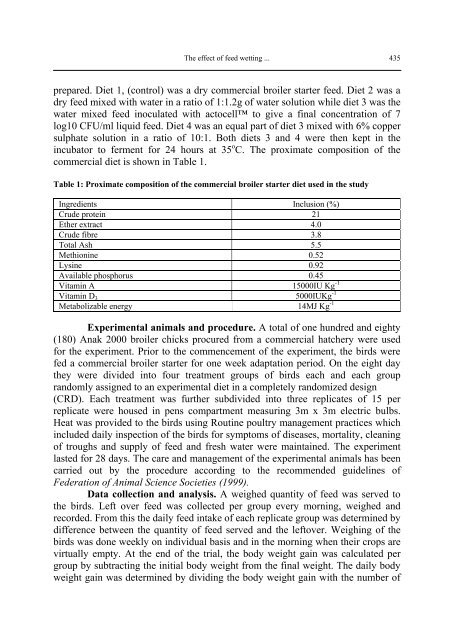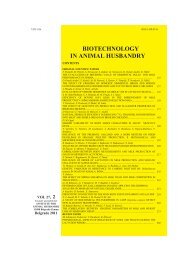Biotechnology in Animal Husbandry - Institut za Stočarstvo
Biotechnology in Animal Husbandry - Institut za Stočarstvo
Biotechnology in Animal Husbandry - Institut za Stočarstvo
Create successful ePaper yourself
Turn your PDF publications into a flip-book with our unique Google optimized e-Paper software.
The effect of feed wett<strong>in</strong>g ...<br />
prepared. Diet 1, (control) was a dry commercial broiler starter feed. Diet 2 was a<br />
dry feed mixed with water <strong>in</strong> a ratio of 1:1.2g of water solution while diet 3 was the<br />
water mixed feed <strong>in</strong>oculated with actocell to give a f<strong>in</strong>al concentration of 7<br />
log10 CFU/ml liquid feed. Diet 4 was an equal part of diet 3 mixed with 6% copper<br />
sulphate solution <strong>in</strong> a ratio of 10:1. Both diets 3 and 4 were then kept <strong>in</strong> the<br />
<strong>in</strong>cubator to ferment for 24 hours at 35 o C. The proximate composition of the<br />
commercial diet is shown <strong>in</strong> Table 1.<br />
Table 1: Proximate composition of the commercial broiler starter diet used <strong>in</strong> the study<br />
Ingredients Inclusion (%)<br />
Crude prote<strong>in</strong> 21<br />
Ether extract 4.0<br />
Crude fibre 3.8<br />
Total Ash 5.5<br />
Methion<strong>in</strong>e 0.52<br />
Lys<strong>in</strong>e 0.92<br />
Available phosphorus 0.45<br />
Vitam<strong>in</strong> A 15000IU Kg -1<br />
Vitam<strong>in</strong> D3 5000IUKg -1<br />
Metaboli<strong>za</strong>ble energy 14MJ Kg -1<br />
Experimental animals and procedure. A total of one hundred and eighty<br />
(180) Anak 2000 broiler chicks procured from a commercial hatchery were used<br />
for the experiment. Prior to the commencement of the experiment, the birds were<br />
fed a commercial broiler starter for one week adaptation period. On the eight day<br />
they were divided <strong>in</strong>to four treatment groups of birds each and each group<br />
randomly assigned to an experimental diet <strong>in</strong> a completely randomized design<br />
(CRD). Each treatment was further subdivided <strong>in</strong>to three replicates of 15 per<br />
replicate were housed <strong>in</strong> pens compartment measur<strong>in</strong>g 3m x 3m electric bulbs.<br />
Heat was provided to the birds us<strong>in</strong>g Rout<strong>in</strong>e poultry management practices which<br />
<strong>in</strong>cluded daily <strong>in</strong>spection of the birds for symptoms of diseases, mortality, clean<strong>in</strong>g<br />
of troughs and supply of feed and fresh water were ma<strong>in</strong>ta<strong>in</strong>ed. The experiment<br />
lasted for 28 days. The care and management of the experimental animals has been<br />
carried out by the procedure accord<strong>in</strong>g to the recommended guidel<strong>in</strong>es of<br />
Federation of <strong>Animal</strong> Science Societies (1999).<br />
Data collection and analysis. A weighed quantity of feed was served to<br />
the birds. Left over feed was collected per group every morn<strong>in</strong>g, weighed and<br />
recorded. From this the daily feed <strong>in</strong>take of each replicate group was determ<strong>in</strong>ed by<br />
difference between the quantity of feed served and the leftover. Weigh<strong>in</strong>g of the<br />
birds was done weekly on <strong>in</strong>dividual basis and <strong>in</strong> the morn<strong>in</strong>g when their crops are<br />
virtually empty. At the end of the trial, the body weight ga<strong>in</strong> was calculated per<br />
group by subtract<strong>in</strong>g the <strong>in</strong>itial body weight from the f<strong>in</strong>al weight. The daily body<br />
weight ga<strong>in</strong> was determ<strong>in</strong>ed by divid<strong>in</strong>g the body weight ga<strong>in</strong> with the number of<br />
435




